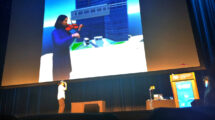Focusing on one specific point in the sky for days, weeks and months on end.
Comparatively cheap and modestly sized telescopes are perfectly capable of delivering scientific data just as valuable as their extremely expensive counterparts, e.g. hi-tech super-telescopes like the Very Large Telescope in Chile or satellite-based telescopes like the NASA/MIT TESS satellite. To do that, the small telescopes just need to work together. By connecting a number of identical small telescopes – one taking over from the other when morning comes – you can observe stars 24/7 and thus gather data that can compete with images from very large stand-alone telescopes.
This is the idea behind the Stellar Observations Network Group, SONG, an astronomical project launched by Danish astronomers in 2006. The vision of SONG is to create a network of small, interconnected, robotic telescopes scattered across the globe, to be able to focus on one specific point in the sky. One telescope will take over when the Sun rises in one place and has set in another. To do this from Earth and to cover the entire sky, 4 telescopes on each hemisphere are needed.

Curious to learn where these 4 telescopes will be placed and how our NRENs are involved? Read the full story on our In The Field Blog.








Add Comment